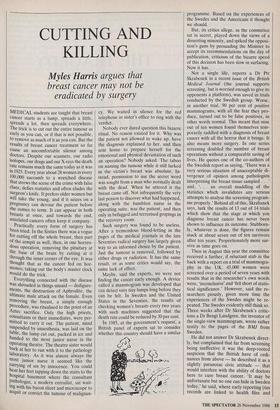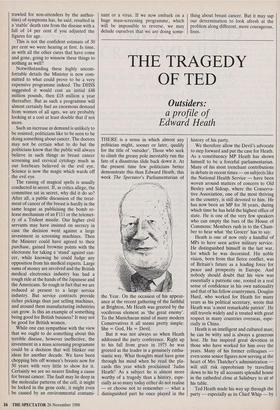CUTTING AND KILLING
Myles Harris argues that
breast cancer may not be eradicated by surgery
MEDICAL students are taught that breast cancer starts as a lump, spreads a little, spreads a lot, then spreads everywhere. The trick is to cut out the entire tumour as early as you can, or if that is not possible, to remove as much of it as you can. But the results of breast cancer treatment so far cause an uncomfortable silence among doctors. Despite our scanners, our radio isotopes, our drugs and our X-rays the death rate remains much the same today as it was in 1925. Every year about 28 women in every 100,000 succumb to a wretched disease that strews the scene of the crime with false clues, defies statistics and often eludes the surgeon's knife. It prefers older women but will take the young, and if it seizes on a pregnancy can devour the patient before she comes to term. It can appear in both breasts at once, and towards the end, unrelated cancers often keep it company. Practically every form of surgery has been tried. In the Sixties there was a vogue for cutting off the whole breast, then part of the armpit as well, then, in one horren- dous operation, removing the pituitary at the base of the brain by cutting at it through the inner corner of the eye. It was thought that as the cancer fed on hor- mones; taking out the body's master clock would do the trick.
Everything connected with the disease was shrouded in things unsaid — disfigure- ments, the destruction of Aphrodite, the ultimate male attack on the female. Even removing the breast, a simple enough procedure, was ritualised to the point of an Aztec sacrifice. Only the high priests, consultants or their immediates, were per- mitted to carry it out. The patient, mind suspended by anaesthesia, was laid on the table, the lump cut out, packed in ice and handed to the most junior nurse in the operating theatre. The theatre sister would bark at her to run with it to the pathology laboratory. As it was almost always the most junior nurse it seemed like the carrying of sin by innocence. You could hear her feet tapping down the stairs to the hospital basement where the consultant pathologist, a modern entrailist, sat wait- ing with his bacon slicer and microscope to acquit or convict the tumour of malignan- cy. We waited in silence for the red telephone in sister's office to ring with the verdict.
Nobody ever dared question this bizarre ritual. No reason existed for it. Why was the patient not allowed to wake up, have the diagnosis explained to her, and then sent home to prepare herself for the emotional and physical devastation of such an operation? Nobody asked. The taboo on naming the tumour while it still lurked in the victim's breast was absolute. In- stead, permission to use the secret word was sought from a man who normally dealt with the dead. When he uttered it the breast came off. Not infrequently the very last person to discover what had happened, along with the humblest nurse in the operating suite, was the patient, and then only in befugged and terrorised gropings in the recovery room.
Such surgery was found to be useless. After a tremendous blood-letting in the pages of the medical journals in the late Seventies radical surgery has largely given way to an informed choice by the patient. Just the tumour is removed, followed by either drugs or radiation. It has the same result, or as some critics would say, the same lack of effect.
Maybe, said the experts, we were not finding the cancer early enough. A device called a mammogram was developed that can detect very tiny lumps long before they can be felt. In Sweden and the United States in the Seventies, the results of checking women's breasts every two years with such machines suggested that the death rate could be reduced by 30 per cent.
In 1985, at the government's request; a British panel of experts sat to consider whether this country should have a similar programme. Based on the experiences of the Swedes and the Americans it thought we should.
But, its critics allege, as the committee sat in secret, played down the views of a dissenting minority, and spiked the opposi- tion's guns by persuading the Minister to accept its recommendations on the day of publication, criticism of the bizarre speed of this decision has been slow in surfacing. Now it has.
Not a single life, reports a Dr Ptr Skrabenek in a recent issue of the British Medical Journal (the journal supports screening, but is worried enough to give its opponents a platform), was saved in trials conducted by the Swedish group. Worse, in another trial, 90 per cent of positive mammograms, with all the fear they pro- duce, turned out to be false positives, in other words normal. This meant that nine out of ten women found themselves tem- porarily saddled with a diagnosis of breast cancer with all the horror that it brings. It also means more surgery. In one series screening doubled the number of breast operations without a comparable saving of lives. He quotes one of the co-authors of the Swedish report as saying, 'There was a very serious situation of unacceptable di- vergence of opinion among pathologists interpreting the breast tissue sampled . .
and, `. . an overall muddling of the statistics which invalidates any serious attempts to analyse the screening program- me properly.' Behind all of this, Skrabanek says, lurk the results of 13 out of 14 trials which show that the stage at which you diagnose breast cancer has never been shown to influence its outcome. Stubborn- ly, whatever is done, the figures remain stuck at about seven out of ten survivors after ten years. Proportionately more sur- vive as time goes on.
Then in August this year the committee received a further, if reluctant stab in the back with a report on a trial of mammogra- phy in the UK. 45,000 women were screened over a period of seven years with results that in the researcher's own words were, 'inconclusive' and 'fell short of statis- tical significance.' However, said the re- searchers piously, given more time the experiences of the Swedes might be re- peated. The Swedes evidently still think so.
Three weeks after Dr Skrabenek's critic- isms a Dr Bengt Lundgren, the inventor of the single-view mammogram, wrote rather testily to the pages of the BMJ from Sweden.
He did not answer Dr Skrabenek direct- ly, but complained that far from screening being ineffective it was the deep-rooted suspicion that the British have of ordi- nances from above — he described it as a slightly paranoiac civic attitude — that would interfere with the ability of doctors here to cure breast cancer. 'It may be unfortunate but no one can hide in Sweden today,' he said, where early reporting (tax records are linked to health files and trawled for non-attenders by the author- ities) of symptoms has, he said, resulted in a 'stable' death rate from the disease with a fall of 14 per cent if you adjusted the figures for age.
This is not the confident estimate of 30 per cent we were hearing at first. Is time, as with all the other cures that have come and gone, going to winnow these things to nothing as well?
Notwithstanding these highly uncom- fortable details the Minister is now com- mitted to what could prove to be a very expensive programme indeed. The DHSS suggested it would cost an initial £48 million pounds, then £18 million a year thereafter. But as such a programme will almost certainly fuel an enormous demand from women of all ages, we are probably looking at a cost at least double that if not more.
Such an increase in demand is unlikely to be resisted; politicians like to be seen to be doing something about cancer. The doctors may not be certain what to do but the politicians know that the public will always believe in such things as breast cancer screening and cervical cytology much as our forebears believed in the evil eye. Science is now the magic which wards off the evil eye.
The raising of magical spells is usually conducted in secret. If, as critics allege, the committee sat in secret, why did it do so? After all, a public discussion of the treat- ment of cancer of the breast is hardly in the same league as publicising the bomb re- lease mechanism of an F111 or the telemet- ry of a Trident missile. Our higher civil servants may have insisted on secrecy in case the decision went against a large investment in screening machines. Then the Minister could have agreed to their purchase, gained brownie points with the electorate for taking a 'stand' against can- cer, while knowing he could fudge any opposition from his medical experts. Large sums of money are involved and the British medical electronics industry has had a rough ride at the hands of the Japanese and the Americans. So rough in fact that we are reduced at present to a large service industry. But service contracts provide richer pickings than just selling machines, and around them manufacturing industries can grow. Is this an example of something being good for British business? It may not be good for British women.
While one can sympathise with the view that we ought to do something about this terrible disease, however ineffective, the investment in a mass screening programme could be a decision that will blinker our ideas for another decade. We have been chopping bits off women's breasts now for 50 years with very little to show for it. Certainly we are no nearer finding a cause for breast cancer. The fault may lie deep in the molecular patterns of the cell, it might be locked in the gene code, it might even be caused by an environmental contami- nant or a virus. If we now embark on a huge mass-screening programme, which will be impossible to reverse, we may delude ourselves that we are doing some- thing about breast cancer. But it may sap our determination to look afresh at the problem along different, more courageous, lines.











































































 Previous page
Previous page